child lock GMC SIERRA CLASSIC 2007 Owners Manual
[x] Cancel search | Manufacturer: GMC, Model Year: 2007, Model line: SIERRA CLASSIC, Model: GMC SIERRA CLASSIC 2007Pages: 674, PDF Size: 3.5 MB
Page 1 of 674
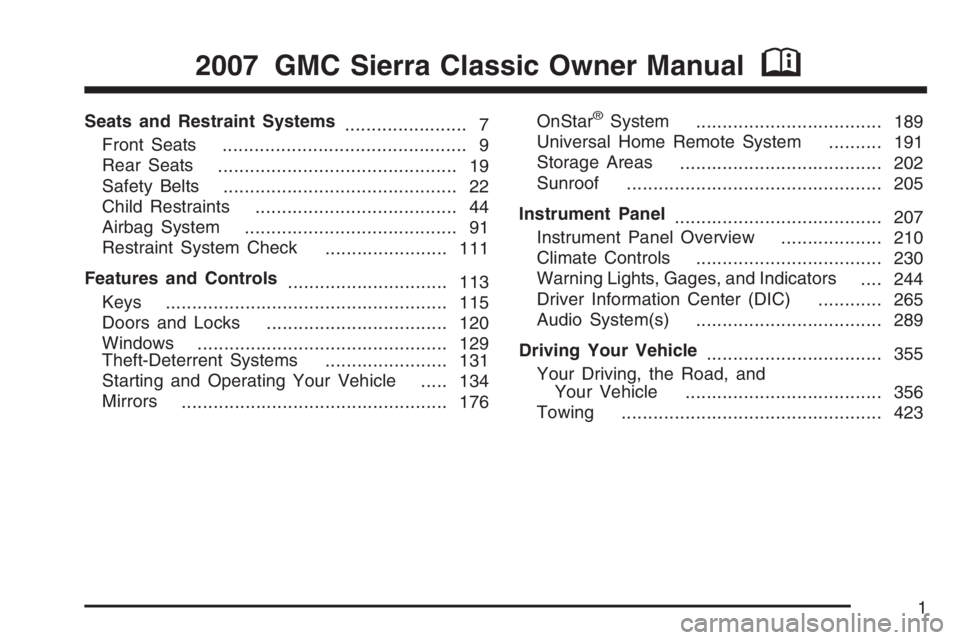
Seats and Restraint Systems
....................... 7
Front Seats
.............................................. 9
Rear Seats
............................................. 19
Safety Belts
............................................ 22
Child Restraints
...................................... 44
Airbag System
........................................ 91
Restraint System Check
....................... 111
Features and Controls
.............................. 113
Keys
..................................................... 115
Doors and Locks
.................................. 120
Windows
............................................... 129
Theft-Deterrent Systems
....................... 131
Starting and Operating Your Vehicle
..... 134
Mirrors
.................................................. 176OnStar®System
................................... 189
Universal Home Remote System
.......... 191
Storage Areas
...................................... 202
Sunroof
................................................ 205
Instrument Panel
....................................... 207
Instrument Panel Overview
................... 210
Climate Controls
................................... 230
Warning Lights, Gages, and Indicators
.... 244
Driver Information Center (DIC)
............ 265
Audio System(s)
................................... 289
Driving Your Vehicle
................................. 355
Your Driving, the Road, and
Your Vehicle
..................................... 356
Towing
................................................. 423
2007 GMC Sierra Classic Owner ManualM
1
Page 27 of 674
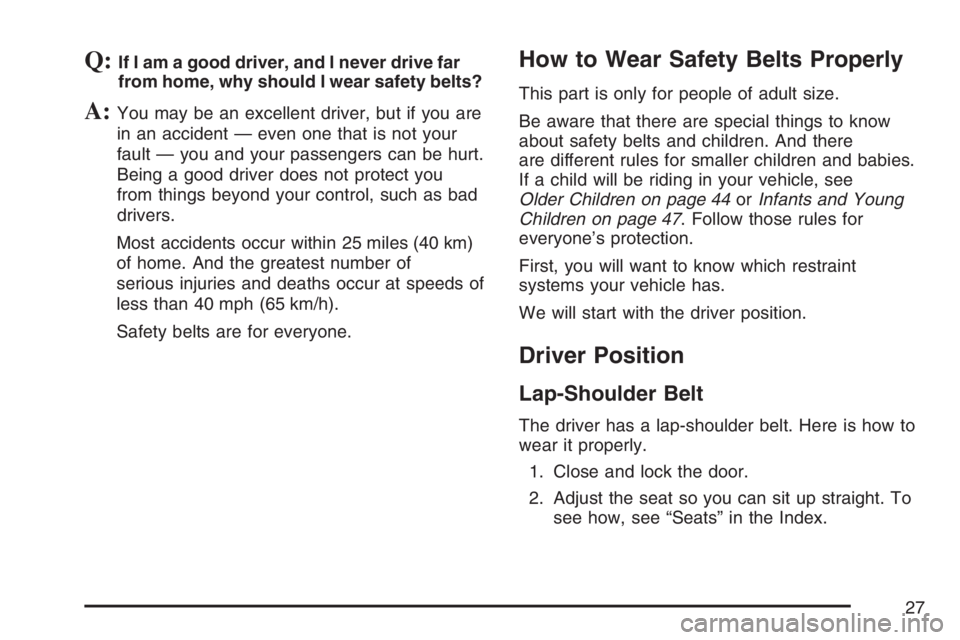
Q:If I am a good driver, and I never drive far
from home, why should I wear safety belts?
A:You may be an excellent driver, but if you are
in an accident — even one that is not your
fault — you and your passengers can be hurt.
Being a good driver does not protect you
from things beyond your control, such as bad
drivers.
Most accidents occur within 25 miles (40 km)
of home. And the greatest number of
serious injuries and deaths occur at speeds of
less than 40 mph (65 km/h).
Safety belts are for everyone.
How to Wear Safety Belts Properly
This part is only for people of adult size.
Be aware that there are special things to know
about safety belts and children. And there
are different rules for smaller children and babies.
If a child will be riding in your vehicle, see
Older Children on page 44orInfants and Young
Children on page 47. Follow those rules for
everyone’s protection.
First, you will want to know which restraint
systems your vehicle has.
We will start with the driver position.
Driver Position
Lap-Shoulder Belt
The driver has a lap-shoulder belt. Here is how to
wear it properly.
1. Close and lock the door.
2. Adjust the seat so you can sit up straight. To
see how, see “Seats” in the Index.
27
Page 37 of 674
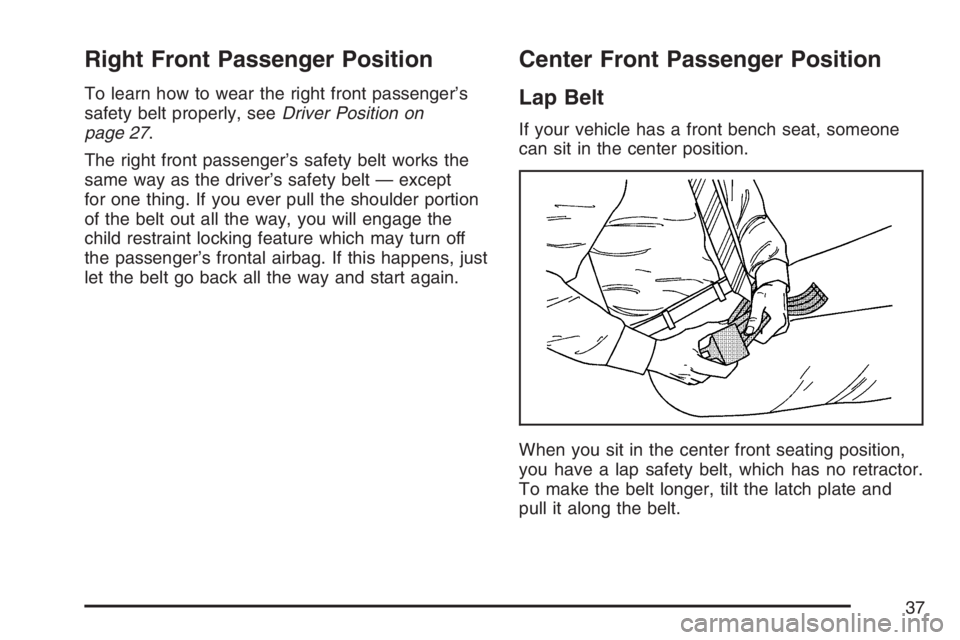
Right Front Passenger Position
To learn how to wear the right front passenger’s
safety belt properly, seeDriver Position on
page 27.
The right front passenger’s safety belt works the
same way as the driver’s safety belt — except
for one thing. If you ever pull the shoulder portion
of the belt out all the way, you will engage the
child restraint locking feature which may turn off
the passenger’s frontal airbag. If this happens, just
let the belt go back all the way and start again.
Center Front Passenger Position
Lap Belt
If your vehicle has a front bench seat, someone
can sit in the center position.
When you sit in the center front seating position,
you have a lap safety belt, which has no retractor.
To make the belt longer, tilt the latch plate and
pull it along the belt.
37
Page 65 of 674
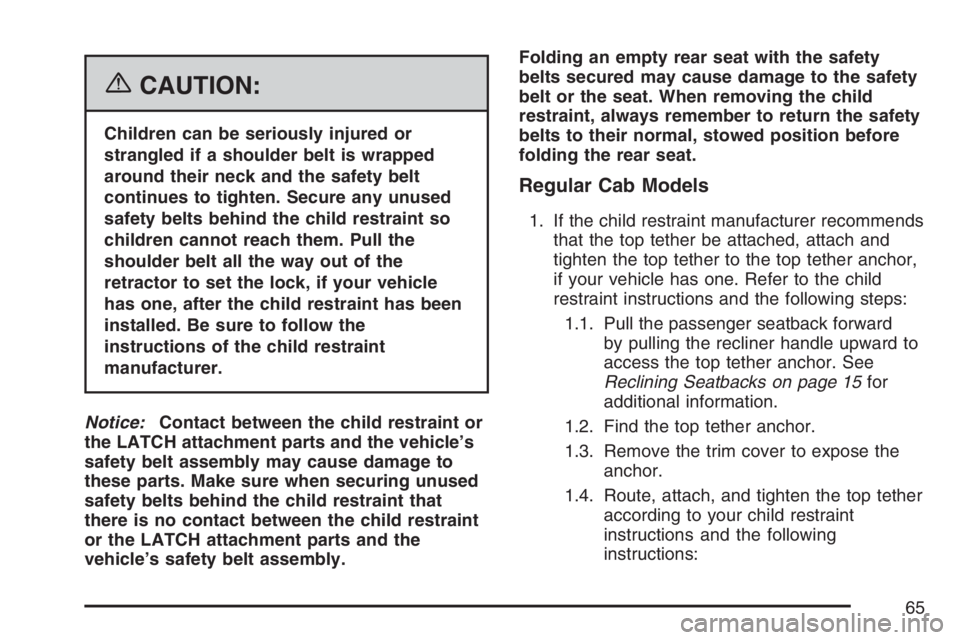
{CAUTION:
Children can be seriously injured or
strangled if a shoulder belt is wrapped
around their neck and the safety belt
continues to tighten. Secure any unused
safety belts behind the child restraint so
children cannot reach them. Pull the
shoulder belt all the way out of the
retractor to set the lock, if your vehicle
has one, after the child restraint has been
installed. Be sure to follow the
instructions of the child restraint
manufacturer.
Notice:Contact between the child restraint or
the LATCH attachment parts and the vehicle’s
safety belt assembly may cause damage to
these parts. Make sure when securing unused
safety belts behind the child restraint that
there is no contact between the child restraint
or the LATCH attachment parts and the
vehicle’s safety belt assembly.Folding an empty rear seat with the safety
belts secured may cause damage to the safety
belt or the seat. When removing the child
restraint, always remember to return the safety
belts to their normal, stowed position before
folding the rear seat.
Regular Cab Models
1. If the child restraint manufacturer recommends
that the top tether be attached, attach and
tighten the top tether to the top tether anchor,
if your vehicle has one. Refer to the child
restraint instructions and the following steps:
1.1. Pull the passenger seatback forward
by pulling the recliner handle upward to
access the top tether anchor. See
Reclining Seatbacks on page 15for
additional information.
1.2. Find the top tether anchor.
1.3. Remove the trim cover to expose the
anchor.
1.4. Route, attach, and tighten the top tether
according to your child restraint
instructions and the following
instructions:
65
Page 77 of 674
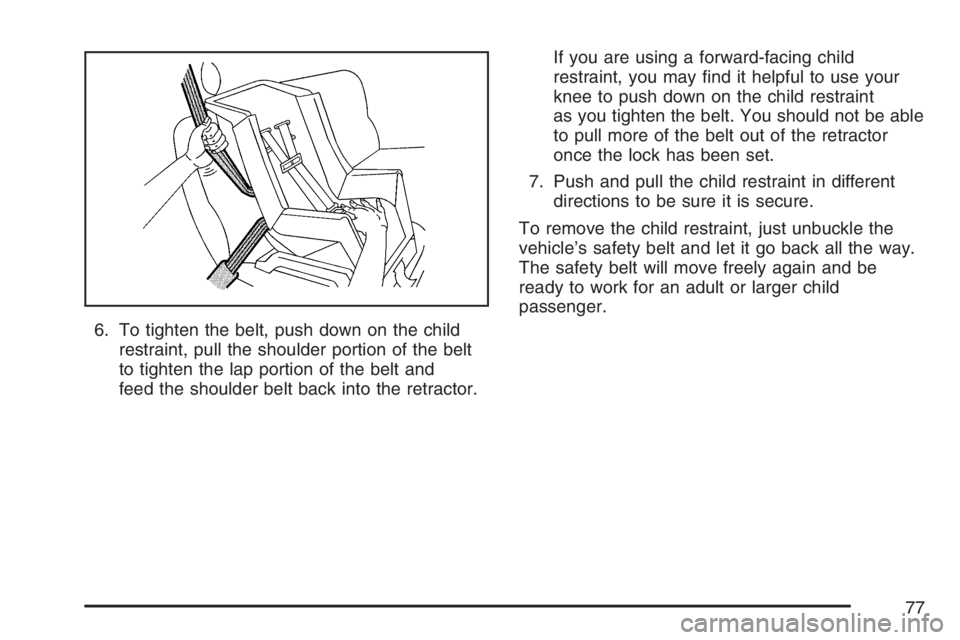
6. To tighten the belt, push down on the child
restraint, pull the shoulder portion of the belt
to tighten the lap portion of the belt and
feed the shoulder belt back into the retractor.If you are using a forward-facing child
restraint, you may �nd it helpful to use your
knee to push down on the child restraint
as you tighten the belt. You should not be able
to pull more of the belt out of the retractor
once the lock has been set.
7. Push and pull the child restraint in different
directions to be sure it is secure.
To remove the child restraint, just unbuckle the
vehicle’s safety belt and let it go back all the way.
The safety belt will move freely again and be
ready to work for an adult or larger child
passenger.
77
Page 82 of 674
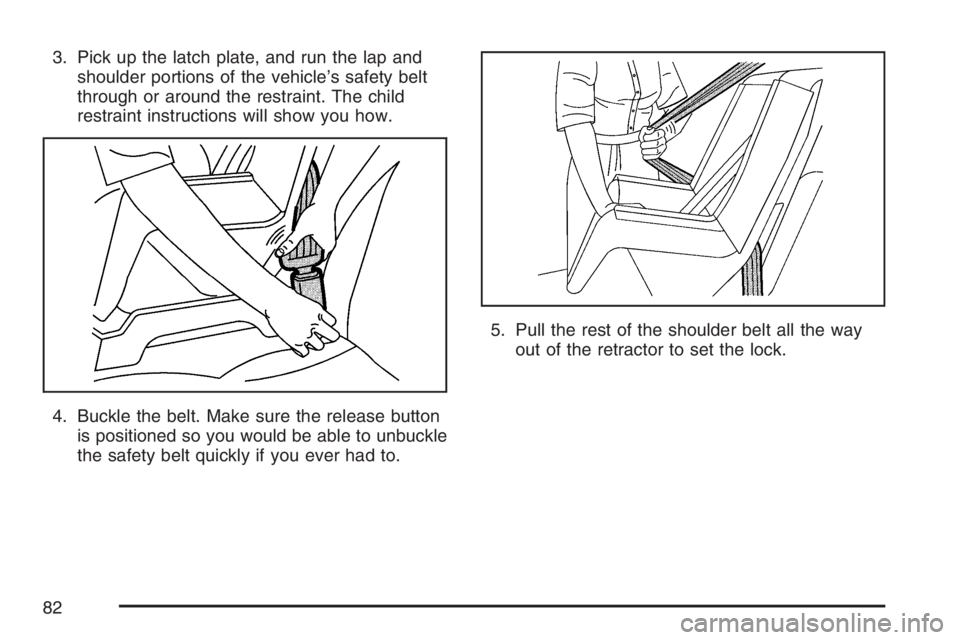
3. Pick up the latch plate, and run the lap and
shoulder portions of the vehicle’s safety belt
through or around the restraint. The child
restraint instructions will show you how.
4. Buckle the belt. Make sure the release button
is positioned so you would be able to unbuckle
the safety belt quickly if you ever had to.5. Pull the rest of the shoulder belt all the way
out of the retractor to set the lock.
82
Page 83 of 674
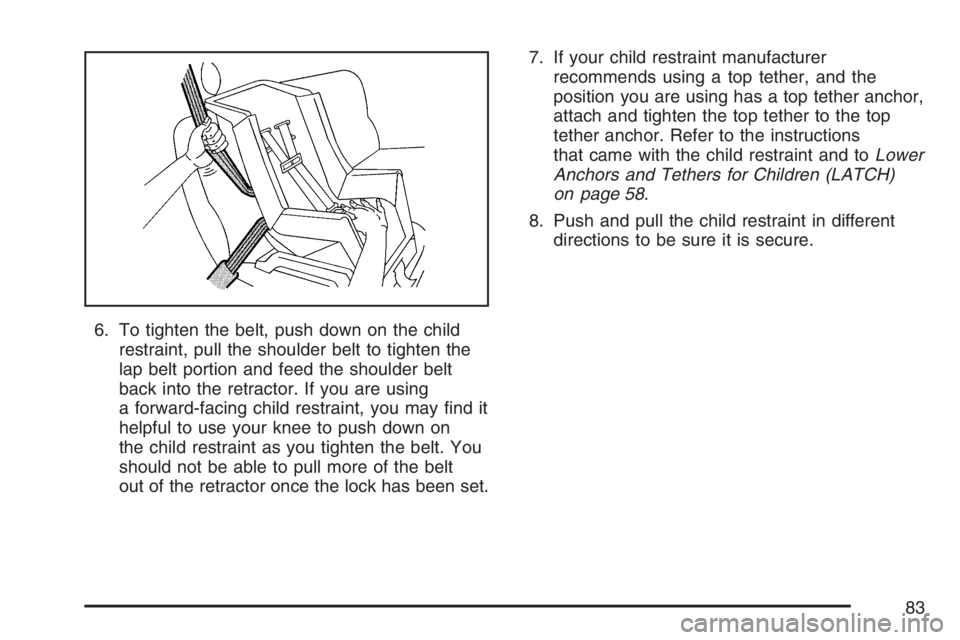
6. To tighten the belt, push down on the child
restraint, pull the shoulder belt to tighten the
lap belt portion and feed the shoulder belt
back into the retractor. If you are using
a forward-facing child restraint, you may �nd it
helpful to use your knee to push down on
the child restraint as you tighten the belt. You
should not be able to pull more of the belt
out of the retractor once the lock has been set.7. If your child restraint manufacturer
recommends using a top tether, and the
position you are using has a top tether anchor,
attach and tighten the top tether to the top
tether anchor. Refer to the instructions
that came with the child restraint and toLower
Anchors and Tethers for Children (LATCH)
on page 58.
8. Push and pull the child restraint in different
directions to be sure it is secure.
83
Page 89 of 674
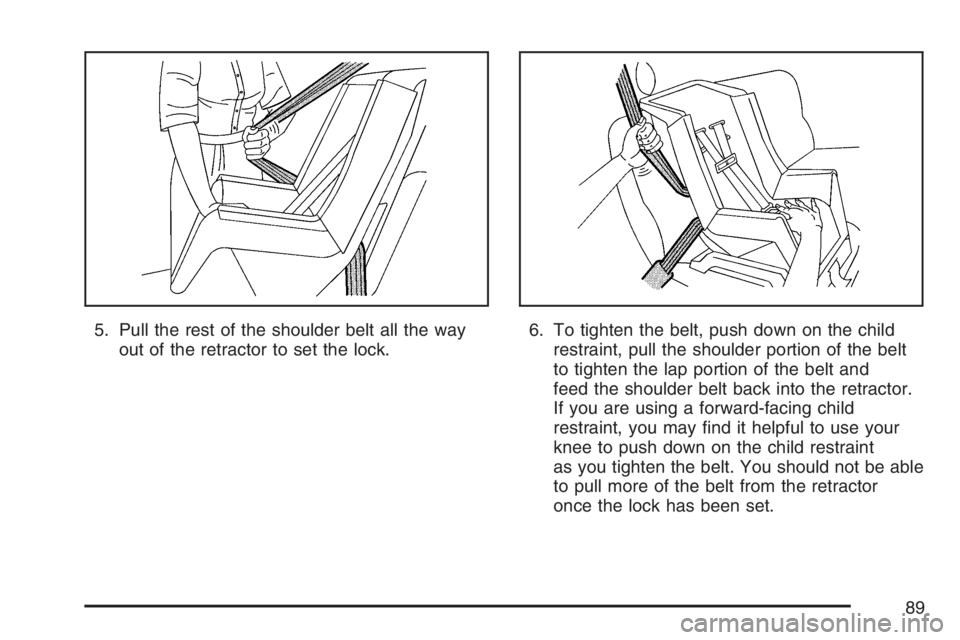
5. Pull the rest of the shoulder belt all the way
out of the retractor to set the lock.6. To tighten the belt, push down on the child
restraint, pull the shoulder portion of the belt
to tighten the lap portion of the belt and
feed the shoulder belt back into the retractor.
If you are using a forward-facing child
restraint, you may �nd it helpful to use your
knee to push down on the child restraint
as you tighten the belt. You should not be able
to pull more of the belt from the retractor
once the lock has been set.
89
Page 120 of 674
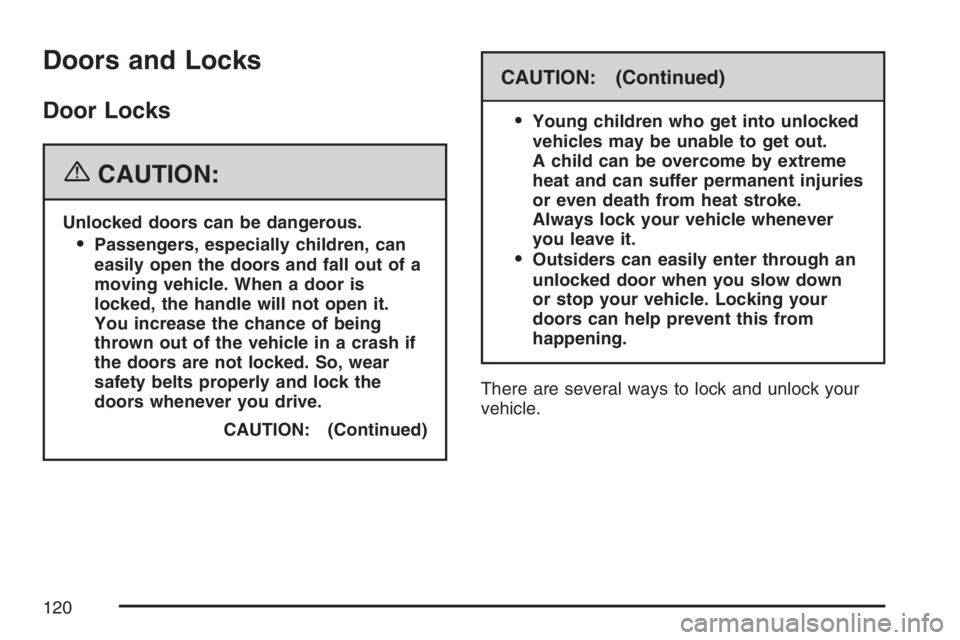
Doors and Locks
Door Locks
{CAUTION:
Unlocked doors can be dangerous.
Passengers, especially children, can
easily open the doors and fall out of a
moving vehicle. When a door is
locked, the handle will not open it.
You increase the chance of being
thrown out of the vehicle in a crash if
the doors are not locked. So, wear
safety belts properly and lock the
doors whenever you drive.
CAUTION: (Continued)
CAUTION: (Continued)
Young children who get into unlocked
vehicles may be unable to get out.
A child can be overcome by extreme
heat and can suffer permanent injuries
or even death from heat stroke.
Always lock your vehicle whenever
you leave it.
Outsiders can easily enter through an
unlocked door when you slow down
or stop your vehicle. Locking your
doors can help prevent this from
happening.
There are several ways to lock and unlock your
vehicle.
120
Page 127 of 674
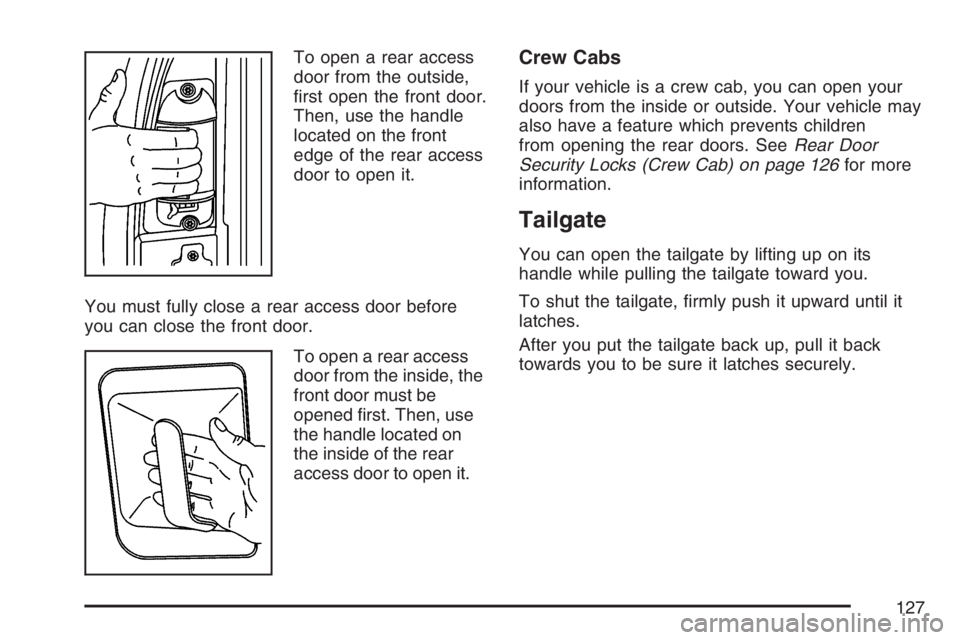
To open a rear access
door from the outside,
�rst open the front door.
Then, use the handle
located on the front
edge of the rear access
door to open it.
You must fully close a rear access door before
you can close the front door.
To open a rear access
door from the inside, the
front door must be
opened �rst. Then, use
the handle located on
the inside of the rear
access door to open it.Crew Cabs
If your vehicle is a crew cab, you can open your
doors from the inside or outside. Your vehicle may
also have a feature which prevents children
from opening the rear doors. SeeRear Door
Security Locks (Crew Cab) on page 126for more
information.
Tailgate
You can open the tailgate by lifting up on its
handle while pulling the tailgate toward you.
To shut the tailgate, �rmly push it upward until it
latches.
After you put the tailgate back up, pull it back
towards you to be sure it latches securely.
127